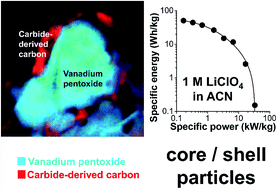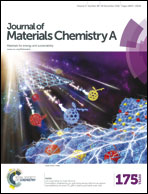Vanadium pentoxide/carbide-derived carbon core–shell hybrid particles for high performance electrochemical energy storage†
Abstract
A novel, two step synthesis is presented combining the formation of carbide-derived carbon (CDC) and redox-active vanadium pentoxide (V2O5) in a core–shell manner using solely vanadium carbide (VC) as the precursor. In a first step, the outer part of VC particles is transformed to nanoporous CDC owing to the in situ formation of chlorine gas from NiCl2 at 700 °C. In a second step, the remaining VC core is calcined in synthetic air to obtain V2O5/CDC core–shell particles. Materials characterization by means of electron microscopy, Raman spectroscopy, and X-ray diffraction clearly demonstrates the partial transformation from VC to CDC, as well as the successive oxidation to V2O5/CDC core–shell particles. Electrochemical performance was tested in organic 1 M LiClO4 in acetonitrile using half- and asymmetric full-cell configuration. High specific capacities of 420 mA h g−1 (normalized to V2O5) and 310 mA h g−1 (normalized to V2O5/CDC) were achieved. The unique nanotextured core–shell architecture enables high power retention with ultrafast charging and discharging, achieving more than 100 mA h g−1 at 5 A g−1 (rate of 12C). Asymmetric cell design with CDC on the positive polarization side leads to a high specific energy of up to 80 W h kg−1 with a superior retention of more than 80% over 10 000 cycles and an overall energy efficiency of up to 80% at low rates.


 Please wait while we load your content...
Please wait while we load your content...